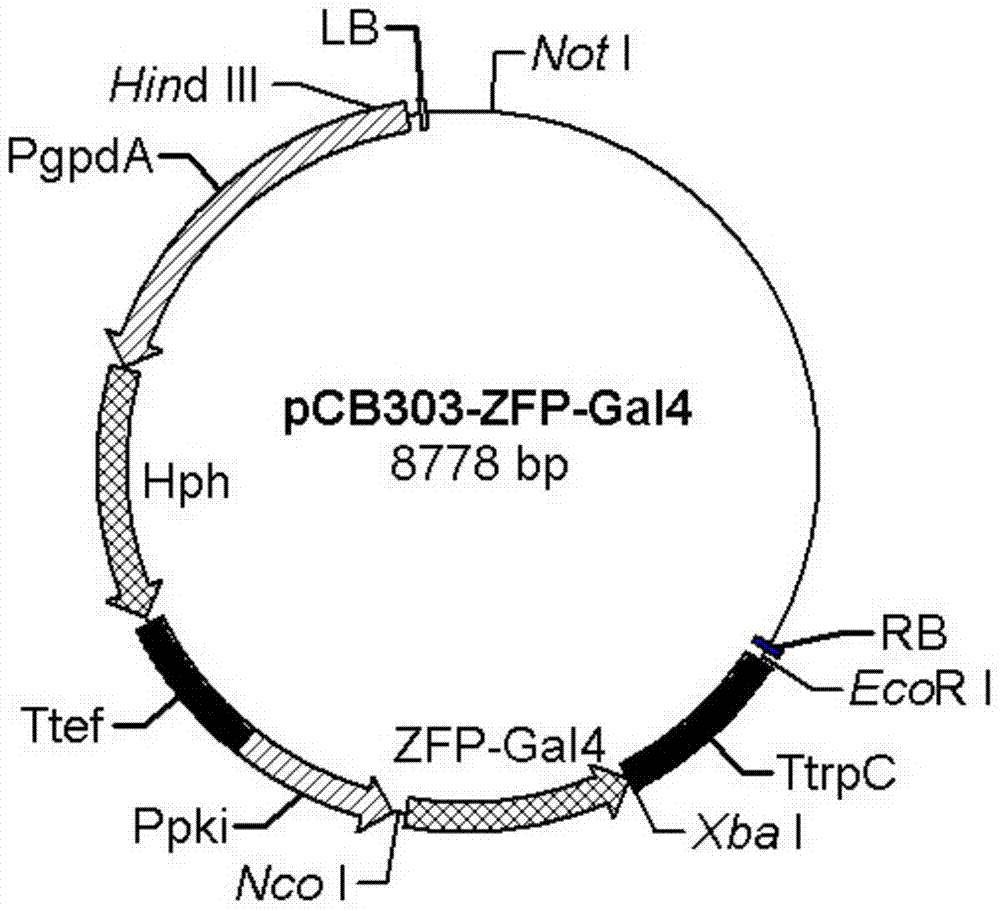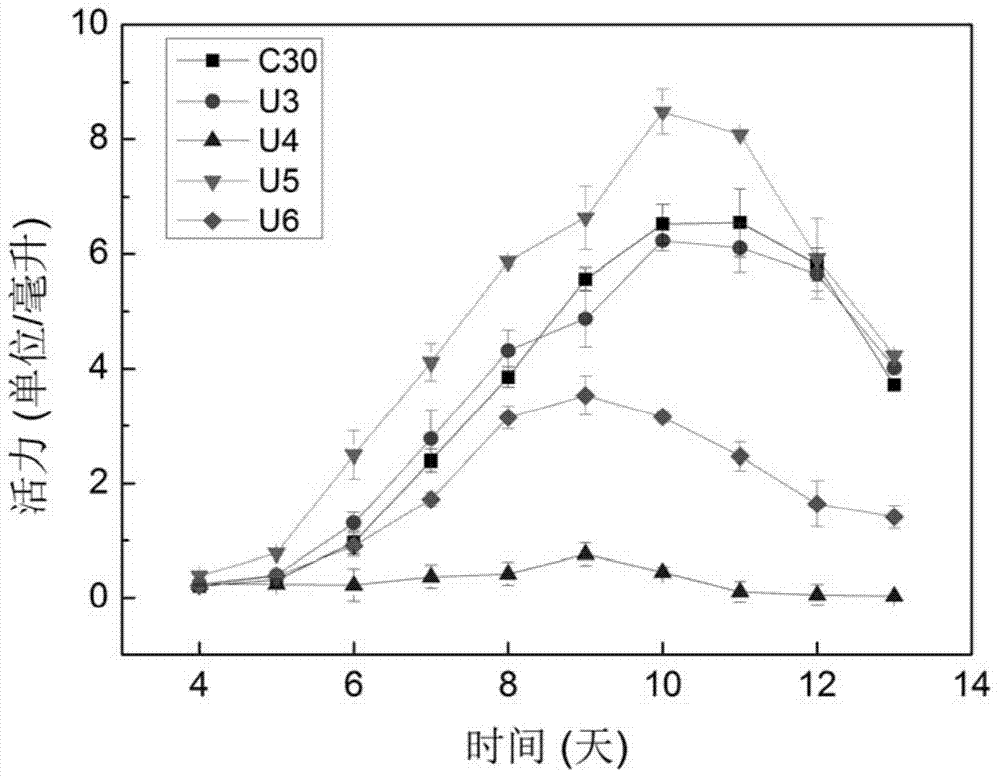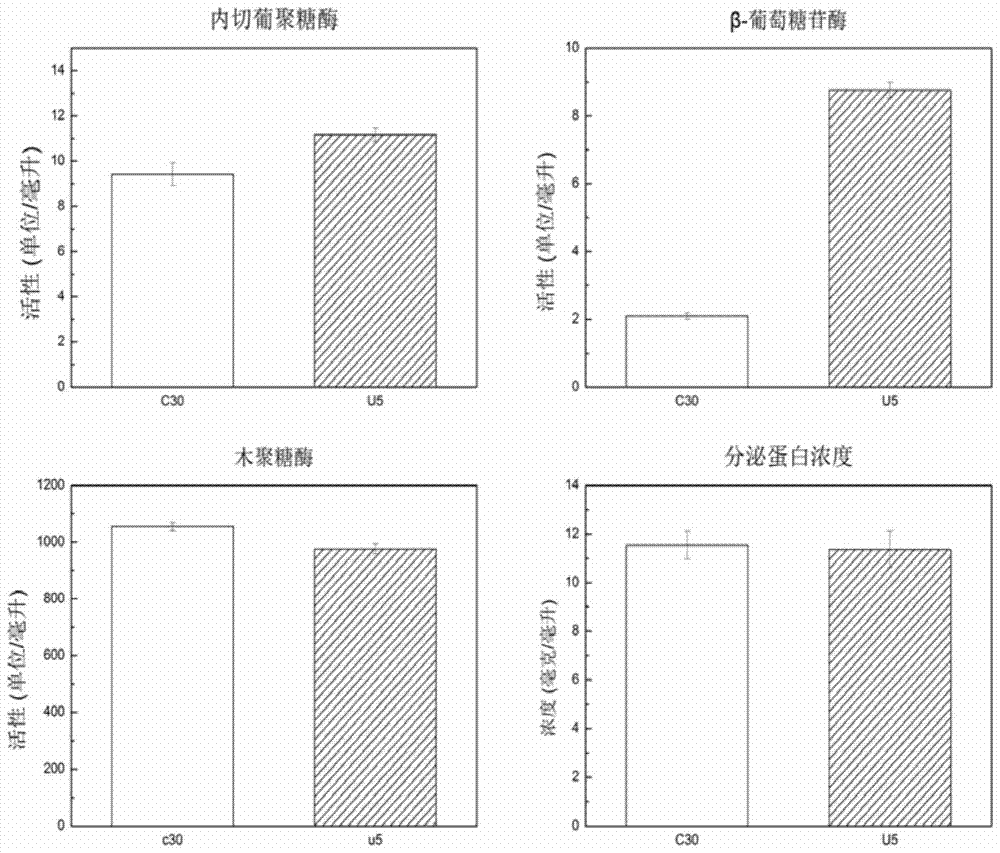A recombinant strain of Trichoderma reesei containing artificial zinc finger transcription factor and its application
A transcription factor, Trichoderma reesei technology, applied in the field of microbial biology, can solve problems such as no reports
- Summary
- Abstract
- Description
- Claims
- Application Information
AI Technical Summary
Problems solved by technology
Method used
Image
Examples
Embodiment 1
[0031] Example 1: Trichoderma reesei zinc finger protein library construction
[0032]The artificial zinc finger involved in the present invention is a Cys2His2 type zinc finger. The construction method refers to NatureBiotechnology, 2003, 21: 1208-1214. It contains four zinc finger domains and is provided by ToolGen Company of Korea. This zinc finger library is characterized by the conserved transcription factor activation domain Gal4 from Saccharomyces cerevisiae, and the variable C2H2 zinc finger binding domain, and the library capacity is about 10 6 The backbone of the binary expression vector is pCB303, which is composed of filamentous fungal expression vectors pAN7-1 (reference Gene, 1987, 56: 117-124) and pCB301 (reference Plant Molecular Biology, 1999, 40: 711-717) modified from Trichoderma reesei, which contains pki promoter and trp The C terminator can insert the nucleic acid sequence of the zinc finger protein library between the two restriction sites. The zinc...
Embodiment 2
[0050] Example 2: Transformation of zinc finger protein Agrobacterium tumefaciens AGL-1 library into Trichoderma reesei C30
[0051] 1. Agrobacterium tumefaciens AGL-1 library containing zinc finger protein was inoculated in 5 ml of culture medium (100 micrograms per milliliter of victor per milliliter of kanamycin) at 1% inoculum size, 28 degrees Celsius, 240 rpm in dark Cultivate for 48 hours; centrifuge at 5000 rpm for 10 minutes, collect Agrobacterium cells, and suspend in induction medium (IM) to adjust OD 660 It is about 0.2, and cultured for 6-12 hours according to the same conditions.
[0052] 2. Inoculate Trichoderma reesei C30 on a PDA plate, culture for 5-7 days under light at 28 degrees Celsius, wash the conidia with sterile water, and adjust to a final concentration of about 10 7 spores per milliliter.
[0053] 3. Take 100 microliters of activated AGL-1 and the same volume of C30 spore suspension, mix them evenly, and evenly spread them on the cellophane covered...
Embodiment 3
[0055] Example 3: Cellulose Activity Screening of Trichoderma reesei Transformants Containing Zinc Finger Proteins
[0056] Transformants of Trichoderma reesei were identified by PCR and resistance screening, and the transformants were screened for mutants with improved cellulase activity by the cellulose liquid shake flask method. Add 50 milliliters of shaking flask screening medium to a 100 milliliter Erlenmeyer flask, and insert about 10 of Trichoderma reesei transformants activated for 7 days to produce spores. 8 per milliliter, at 150 rpm, cultured in a shaker at 28 degrees centigrade, and the culture solution was drawn to measure the enzyme activity of the cellulose filter paper. The wild-type Trichoderma reesei C30 was used as a control to compare the enzyme activity.
[0057] The strains with obvious changes in cellulase activity obtained from the primary screening were further subjected to liquid enzyme activity fermentation comparisons for further verification.
PUM
 Login to View More
Login to View More Abstract
Description
Claims
Application Information
 Login to View More
Login to View More - R&D
- Intellectual Property
- Life Sciences
- Materials
- Tech Scout
- Unparalleled Data Quality
- Higher Quality Content
- 60% Fewer Hallucinations
Browse by: Latest US Patents, China's latest patents, Technical Efficacy Thesaurus, Application Domain, Technology Topic, Popular Technical Reports.
© 2025 PatSnap. All rights reserved.Legal|Privacy policy|Modern Slavery Act Transparency Statement|Sitemap|About US| Contact US: help@patsnap.com



